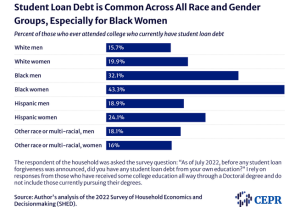By CEPR Photos:
YouTube Screenshots
Forty-three million Americans currently have student loan debt. This group of borrowers collectively owes $1.766 trillion, which is a 267.1% nominal increase from 2006 (Hanson 2023). The burden of student debt is not evenly felt. The data analysis above shows that among surveyed Black or African American people who have attended some college or higher, a disproportionately higher share have student loan debt than other racial groups. The share of student loan debt is also higher for women than men across nearly all racial groups.

The Supreme Court struck down President Biden’s student loan debt forgiveness program in June 2023 that would have canceled $400 million for borrowers. Low- and middle-income borrowers would have seen up to $20,000 in debt relief (Howe 2023). In October of 2023, millions of borrowers were required to return to their repayments after a roughly three-and-a-half-year moratorium that began in March 2020.
Who is the most burdened by these student loans?
An analysis of data from the 2022 Survey of Household Economics and Decisionmaking (SHED) shows that among Black women who have attended some college or higher in their life, 43.3% had student loan debt in 2022. This is roughly two times the percentage of white women (19.9%) and three times the percentage of white men (15.7%). This percentage is up roughly 3 percentage points from 2018 and 1 percentage point from 2019. Black women’s average loan balance is the highest of any group, at $11,000 (Addo and Zhang 2022). A high percentage of Black men also have student debt (32.1%).
Among Hispanic borrowers who attended some college or higher in their educational career, 24.1% of women and 18.9% of men are paying off student loans. White women (19.9%) and men (15.7%) have lower, but still elevated likelihood of carrying student debt. Across three of the racial and ethnic groups, women had higher shares of debt, 4.2 percentage points higher for white women than white men, 5.2 percentage points higher for Hispanic women than men, and 11.2 percentage points higher for Black women than men. The only group in which the percentage of men with student debt was higher than that of women (18.1% and 16%) was those who identify as multi-racial or as another race/ethnicity besides Hispanic, Black, or white.
In the context of how higher education is financed in the US, debt is a necessary tool to access higher education. The distribution of the loans it takes to get the degree and how quickly borrowers are able to pay off their loans has serious impacts on racial and gender equity. Repayment of student loans comes to a perilous intersection with the racial wealth gap and centuries of systemic racism which limit generational wealth (Jackson and Williams 2022; Lee-Sanders 2023).
Even though the Biden administration has been successful in canceling a record $132 billion of federal student loan debt for more than 3.6 million people through existing forgiveness programs on a rolling basis since taking office (US Department of Education 2023), this is just 7.5% of what is still owed. Student loan borrowers — particularly Black borrowers and women — need relief.







